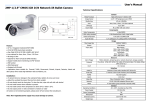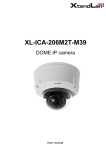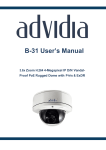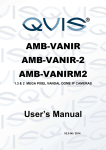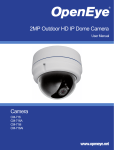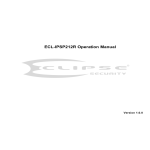Download Manufacturer`s User Manual
Transcript
HD Network Dome Camera User’s Manual Version 1.2.0 Welcome Thank you for purchasing our network camera! This user’s manual is designed to be a reference tool for your system. Please read the following safeguard and warnings carefully before you use this series product! Please keep this user’s manual well for future reference! i Important Safeguards and Warnings 1.Electrical safety All installation and operation here should conform to your local electrical safety codes. The power shall conform to the requirement in the SELV (Safety Extra Low Voltage) and the Limited power source is rated 12V DC or 24V AC in the IEC60950-1. (Refer to general introduction) Please note: Do not connect two power supplying sources to the device at the same time; it may result in device damage! We assume no liability or responsibility for all the fires or electrical shock caused by improper handling or installation. We are not liable for any problems caused by unauthorized modification or attempted repair. 2.Transportation security Heavy stress, violent vibration or water splash are not allowed during transportation, storage and installation. 3.Installation Do not apply power to the camera before completing installation. Please install the proper power cut-off device during the installation connection. Always follow the instruction guide the manufacturer recommended. 4.Qualified engineers needed All the examination and repair work should be done by the qualified service engineers. We are not liable for any problems caused by unauthorized modifications or attempted repair. 5.Environment This series network camera should be installed in a cool, dry place away from direct sunlight, inflammable, explosive substances and etc. Please keep it away from the electromagnetic radiation object and environment. Please make sure the CCD (CMOS) component is out of the radiation of the laser beam device. Otherwise it may result in CCD (CMOS) optical component damage. Please keep the sound ventilation. Do not allow the water and other liquid falling into the camera. Thunder-proof device is recommended to be adopted to better prevent thunder. The grounding studs of the product are recommended to be grounded to further enhance the reliability of the camera. 6. Daily Maintenance Please shut down the device and then unplug the power cable before you begin daily maintenance work. ii Do not touch the CCD (CMOS) optic component. You can use the blower to clean the dust on the lens surface. Always use the dry soft cloth to clean the device. If there is too much dust, please use the water to dilute the mild detergent first and then use it to clean the device. Finally use the dry cloth to clean the device. Please put the dustproof cap to protect the CCD (CMOS) component when you do not use the camera. Dome enclosure is the optical component, do not touch the enclosure when you are installing the device or clean the enclosure when you are doing maintenance work. Please use professional optical clean method to clean the enclosure. Improper enclosure clean method (such as use cloth) may result in poor IR effect of camera with IR function. 7. Accessories Be sure to use all the accessories recommended by manufacturer. Before installation, please open the package and check all the components are included. Contact your local retailer ASAP if something is broken in your package. Accessory Name Amount Network Camera 1 Quick Start Guide 1 Installation Accessories Bag 1 Installation Position Diagram 1 CD 1 iii Table of Contents 1 General Introduction .............................................................................................................. 1 1.1 Overview ................................................................................................................... 1 1.2 Features .................................................................................................................... 1 1.3 Specifications ........................................................................................................... 2 1.3.1 Performance ...................................................................................................... 2 2 Structure ............................................................................................................................... 10 2.1 Dimensions ............................................................................................................. 10 2.2 Port Description ...................................................................................................... 11 2.3 Listening .................................................................................................................. 13 2.4 Bidirectional talk ..................................................................................................... 14 2.4.1 Device-end to PC-end..................................................................................... 14 2.4.2 PC-end to the Device-end .............................................................................. 14 2.5 3 Alarm Setup ............................................................................................................ 14 Installation ............................................................................................................................ 17 3.1 Device Installation Introduction ............................................................................. 17 3.2 Device Installation Steps ....................................................................................... 17 3.2.1 General Installation ......................................................................................... 17 3.2.2 Manual Zoom Lens Focus Operation ............................................................ 20 3.2.3 Side Cable Exit ................................................................................................ 21 3.2.4 Cable Connection ............................................................................................ 21 3.3 Micro SD Card Installation .................................................................................... 22 iv 4 5 6 Quick Configuration Tool .................................................................................................... 24 4.1 Overview ................................................................................................................. 24 4.2 Operation ................................................................................................................ 24 Web Operation ..................................................................................................................... 26 5.1 Network Connection............................................................................................... 26 5.2 Login and Main Interface ....................................................................................... 26 FAQ ....................................................................................................................................... 28 Appendix Toxic or Hazardous Materials or Elements............................................................. 29 v 1 General Introduction 1.1 Overview This series network camera combines traditional camera and network video technology into one unit which integrates A/V data collection and transmission through network without aux devices. It uses advanced H.264 and MJPEG video compression technology and G.711a audio compression technology, which maximally guarantee the audio and video quality. This series network camera enclosure has the strong resistance capacity, which can guarantee the proper work performance under heavy strike. It supports real-time monitor and listening at the same time. It supports analog video output and dual-way bidirectional talk. It can be used alone or used in a network area. When it is used lonely, you can connect it to the network and then use a network client-end. Due to its multiple functions and various uses, this series network camera is widely used in many environments such home, office, bank, road monitor and etc. 1.2 Features User Management Storage Function Alarm Function Network Monitor Network Management Different user rights for each group, one user belongs to one group. The user right shall not exceed the group right. You can edit each group at anytime. Support central server backup function in accordance with your configuration and setup in alarm or schedule setting Support record via Web and the recorded file are storage in the client-end PC. Support built-in Micro SD card. Support network storage like FTP, support short-time storage when encounter disconnection. Real-time respond to external local alarm input and video detect as user predefined activation setup and exert corresponding message in screen and audio prompt(allow user to pre-record audio file) Real-time video detect: motion detect, camera masking. Can generate an alarm when network abnormal, Micro SD card abnormal event occurred. Network camera supports one-channel audio/video data transmit to network terminal and then decode. Delay is within 270ms (network bandwidth support needed) Max supports 20 connections. Adopt the following audio and video transmission protocol: HTTP, TCP, UDP, MULTICAST, RTP/RTCP, RTSP and etc. Support web access, widely used in WAN. Realize network camera configuration and management via Ethernet. Support device management via web or client-end. Support various network protocols. Support the on-off alarm device to alarm via the sound or the light. Peripheral Equipment Power External power adapter DC12V/AC 24V (Only vandal proof series support AC 24V) Support PoE. Warning! Do not connect two power supplying sources to the device at the same time; it may result in device damage! 1 Assistant Function Log function Support PAL/NTSC Day/Night mode auto switch (electromagnetic ICR switch). Auto iris adjustment Built-in IR light. Support IR night vision (For IR Series only). Backlight compensation: screen auto split to realize backlight compensation to adjust the bright. Support electronic shutter and gain setup. Support 3D NR. Support video watermark function to avoid vicious video modification. 1.3 Specifications 1.3.1 Performance System Please refer to the following sheets for network camera performance specification. Model IPC-HD/HDW3100 Series IPC-HD/HDW3200 Series Parameter Main TI Davinci high performance DSP Processor OS Embedded LINUX System Support real-time network monitoring, local record, and remote operation. Resources User Interface Remote operation interface such as WEB, DSS, PSS System Status SD card status, bit stream statistics, log, and software version. Image Sensor 1/3 inch CMOS 1/2.8 inch CMOS Pixel 1280(H)*960(V) 1920 (H)*1080(V) Day/Night Support day/night mode switch and electromagnetic IR-CUT at the same Mode time. Auto Iris DC drive Gain Control Manual/Auto Video Parameter White Balance Manual/Auto BLC Mode On/Off Electronic Shutter Manual/Auto PAL: It ranges from 1/3 to 1/100000. NTSC: It ranges from 1/3 to 1/100000. Video Compression Standard H.264 / H.264H/H.264B/MJPEG Note: Some versions do not support H.264H. Video Rate Frame Video Bit Rate PAL: Main stream (1280*960@15fps) extra stream (704*576@15fps)/ Main stream (1280*720@25fps) Extra stream (704*576@25fps) Main stream (1920*1080@25fps) extra stream (704*576@25fps) NTSC: Main stream (1920*1080@30fps) extra stream (704*480@30fps) NTSC: Main stream (1280*960@15fps) extra stream (704*480@15fps) Main stream (1280*720@30fps) Extra stream (704*480@30fps) H.264: 56Kbps-6144Kbps. It is adjustable MJPEG: adjustable and bit rate is adjustable. Support customized setup. H.264: 56Kbps-8192Kbps. It is adjustable MJPEG: adjustable and bit rate is adjustable. Support customized setup. 2 Video Flip Audio Snapshot Privacy Mask Video Setup Video Information Lens Lens Interface Audio Input Audio Output Audio Bit Rate Audio Compression Standard Video Motion Detect Privacy Mask Alarm Input Support mirror. Support flip function. Max 1f/s snapshot. File extension name is JPEG. Supports max 4 privacy mask zones Support parameter setup such as bright, contrast. Channel title, time title, motion detect, privacy mask. [email protected] ¢14. Lens is the default accessories. 1-channe RCA LINE IN 1-channel RCA LINE OUT 16kbps 16bit [email protected] G.711a/G.711Mu/PCM 396 (18*22) detection zones; sensitivity level ranges from 1 to 6 (6 is max); Activation event, alarm device, audio/video storage, image snapshot, log, email function and etc. Activation event, alarm device, audio/video storage, image snapshot, log, email function and etc. 1-channel input,1-channel output Record and Backup Network AUX Interface General Parameter Record Priority Manual>External alarm >Video detect>Schedule Local Storage Support Micro SD card storage Wired Network Network Protocol Remote Operation Video Output Reset 1-channel wire Ethernet port, 10/100 Base-T Ethernet HTTP,TCP,ARP,RTSP,RTP,UDP,RTCP,SMTP,FTP,DHCP,DNS,DDNS,PP PoE,IPv4/v6,SNMP,QoS,UPnP,NTP. IR light IR distance 20 meters (For IR series product only) Power Power Consumption Working Temperature Working Humidify Dimensions(m m) Weight Installation Support AC24V, DC12V and PoE (AC 24V port is inside the device.) General series: below 3W. General series: below 5W. IR series: below 5W. IR series: below 7W. Model Parameter Monitor, system setup, log information, maintenance , upgrade and etc N/A Built-in RESET button -20℃~+60℃ ≤95% ¢140.3×113.7 0.5 kg Support various installation modes IPC-HDB/HDBW3100 Series IPC-HDB/HDBW3200 Series IPC-HDB/HDBW3301 Series 3 System Video Parameter Main Processor OS System Resources User Interface System Status Image Sensor Pixel Day/Night Mode Auto Iris Gain Control TI Davinci high performance DSP Embedded LINUX Support real-time network monitoring, local record, and remote operation. Remote operation interface such as WEB, DSS, PSS SD card status, bit stream statistics, log, and software version. 1/3 inch CMOS 1/2.8 inch CMOS 1/3 inch CMOS 1280(H)*960(V) 1920 (H)*1080(V) 2048(H)*1536(V) Support day/night mode switch and electromagnetic IR-CUT at the same time. DC drive Manual/Auto White Balance Manual/Auto BLC On/Off Electronic Shutter Manual/Auto PAL: It ranges from 1/3 to 1/100000. NTSC: It ranges from 1/3 to 1/100000. Video Compression Standard H.264 / H.264H/H.264B/MJPEG Note: Some versions do not support H.264H. Video Rate Frame Video Bit Rate Video Flip Snapshot Privacy Mask Video Setup Video Information Lens Lens Interface PAL: Main stream (1280*960@15fps) extra stream (704*576@15fps) Main stream (1280*720@25fps) extra stream (704*576@25fps) PAL: Main stream (1920*1080@25fps) extra stream (704*576@25fps) NTSC: Main stream (1920*1080@30fps) extra stream (704*480@30fps) PAL: Main stream (2048*1536@18fps) extra stream (704*576@18fps) Main stream (1920*1080@25fps) extra stream (704*576@25fps) NTSC: Main stream (2048*1536@20fps) extra stream (704*480@20fps) Main stream (1920*1080@30fps) extra stream (704*480@30fps) NTSC: Main stream (1280*960@15fps) extra stream (704*480@15fps) Main stream (1280*720@30fps) extra stream (704*480@30fps) H.264: 56Kbps6144Kbps. It is H.264: 56Kbps-8192Kbps. It is adjustable adjustable MJPEG is adjustable. Bit rate is adjustable and support customization. Support mirror. Support flip function. Max 1f/s snapshot. File extension name is JPEG. Supports max 4 privacy mask zones Support parameter setup such as bright, contrast. Channel title, time title, motion detect, privacy mask. [email protected] [email protected] ¢14. Lens is the default accessories. 4 Audio Audio Input Audio Output Bidirectional Talk Input Audio Bit Rate Audio Compression Standard Video Motion Detect Privacy Mask Alarm Input 1-channe RCA LINE IN 1-channel RCA LINE OUT Reuse the first audio input channel 16kbps 16bit G.711a/G.711Mu/PCM 396 (18*22) detection zones; sensitivity level ranges from 1 to 6 (6 is max); Activation event, alarm device, audio/video storage, image snapshot, log, email function and etc. Activation event, alarm device, audio/video storage, image snapshot, log, email function and etc. 1-channel input,1-channel output Record and Backup Network AUX Interface Record Priority Manual>External alarm >Video detect>Schedule Local Storage Support Micro SD card storage Wired Network Network Protocol Remote Operation Video Output Reset 1-channel wire Ethernet port, 10/100 Base-T Ethernet HTTP,TCP,ARP,RTSP,RTP,UDP,RTCP,SMTP,FTP,DHCP,DNS,DDNS,PP PoE,IPv4/v6,SNMP,QoS,UPnP,NTP. IR light IR distance 20 meters (For IR series product only) General Parameter Power Power Consumption Working Temperature Working Humidify Dimensions(m m) Weight Installation Model Parameter System Main Processor OS System Monitor, system setup, log information, maintenance , upgrade and etc N/A Built-in RESET button Support DC12V and PoE General series: below 3W. IR series: below 5W. 1-ch analog output, BNC port Support AC 24V/DC12V and PoE General series: below 5W. IR series: below 7W. General series: below 7W. IR series: below 8W. -20℃~+60℃ ≤95% ¢151.1×118.9 ¢151×119 1.25 kg Support various installation modes IPC-HDB/HDBW5100 Series IPC-HDB/HDBW5200 Series IPC-HDB/HDBW5300 High performance DSP Embedded LINUX Support real-time network monitoring, local record, and remote operation. 5 Video Parameter Resources User Interface System Status Image Sensor Pixel Day/Night Mode Auto Iris Gain Control Remote operation interface such as WEB, DSS, PSS Micro SD card status, bit stream statistics, log, and software version. 1/3 inch CMOS 1/2.8 inch CMOS 1/3 inch CMOS 1280(H)*960(V) 1920 (H)*1080(V) 2048 (H)×1536 (V) Support day/night mode switch and electromagnetic IR-CUT at the same time. DC drive Manual/Auto White Balance Manual/Auto BLC On/Off Electronic Shutter Manual/Auto It ranges from 1/3 to 1/100000. Video Compression Standard H.264 / H.264H/MJPEG PAL: Main stream (1280*960@25fps) extra stream (704*576@25fps)/ Main stream (1280*720@25fps) Extra stream (704*576@25fps) Video Rate Frame Video Bit Rate Video Flip Snapshot Privacy Mask Video Setup Video Information Lens PAL: Main stream (1920*1080@25fps) extra stream (704*576@25fps) NTSC: Main stream (1920*1080@30fps) extra stream (704*480@30fps) NTSC: Main stream (1280*960@30fps) extra stream (704*480@30fps)/ Main stream (1280*720@30fps) Extra stream (704*480@30fps) PAL: Main stream (2048*1536@20fps) extra stream(704*576@20fp s), Main stream(1920*1080@25 fps) extra stream(704*576@25f ps) NTSC: Main stream(2048*1536@20 fps) extra stream(704×480@20fp s), Main stream(1920*1080@30 fps) extra stream(704×480@30f ps) H.264: 16Kbps~16Mbps. It is adjustable MJPEG: adjustable and bit rate is adjustable. Support customized setup. Support mirror. Support flip function. Max 1f/s snapshot. File extension name is JPEG. Supports max 4 privacy mask zones Support parameter setup such as bright, contrast. Channel title, time title, motion detect, privacy mask. [email protected] [email protected] 6 Audio Lens Interface Audio Input Audio Output Bidirectional Talk Input Audio Bit Rate Audio Compression Standard Video Motion Detect Privacy Mask Alarm Input ¢14. Lens is the default accessories. 1-channe RCA LINE IN 1-channel RCA LINE OUT Reuse the first audio input channel 16kbps 16bit G.711a/G.711Mu/PCM 396 (18*22) detection zones; sensitivity level ranges from 0 to 100; area threshold 0-100. Activation event, alarm device, audio/video storage, image snapshot, log, email function and etc. Activation event, alarm device, audio/video storage, image snapshot, log, email function and etc. 1-channel input,1-channel output Record and Backup Network AUX Interface General Parameter Record Priority Manual>External alarm >Video detect>Schedule Local Storage Support Micro SD card storage Wired Network Network Protocol Remote Operation Video Output Reset 1-channel wire Ethernet port, 10/100 Base-T Ethernet HTTP,TCP,ARP,RTSP,RTP,UDP,RTCP,SMTP,FTP,DHCP,DNS,DDNS,PP PoE,IPv4/v6,SNMP,QoS,UPnP,NTP. IR light IR distance 20~30 meters (For IPC-HDBW series product only) Power Support AC24V, DC12V and PoE (AC 24V port is inside the device.) General series: below General series: below 5W. 3W. IR series: below 7W. IR series: below 5W. Power Consumption Working Temperature Working Humidify Dimensions(m m) Weight Installation System Model Parameter Main Processor OS System Resources User Interface Monitor, system setup, log information, maintenance , upgrade and etc 1-ch analog output, BNC port (need additional cable) Built-in RESET button -30℃~+60℃ ≤95% ¢151×119 1.25 kg Support various installation modes IPC-HDB/HDBW5100-A2 Series High performance DSP Embedded LINUX Support real-time network monitoring, local record, and remote operation. Remote operation interface such as WEB, DSS, PSS 7 Video Parameter System Status Image Sensor Pixel Day/Night Mode Auto Iris Gain Control Micro SD card status, bit stream statistics, log, and software version. 1/3 inch CMOS White Balance Manual/Auto BLC On/Off Electronic Shutter Manual/Auto It ranges from 1/3 to 1/100000. Video Compression Standard H.264 / H.264H/MJPEG Video Rate Frame Video Bit Rate Video Flip Audio Snapshot Privacy Mask Video Setup Video Information Lens Lens Interface Audio Input Bidirectional Talk Input Audio Bit Rate Audio Compression Standard Video Motion Detect Privacy Mask Alarm Input 1280(H)*960(V) Support day/night mode switch and electromagnetic IR-CUT at the same time. DC drive Manual/Auto PAL: Main stream (1280*960@25fps) extra stream (704*576@25fps)/ Main stream (1280*720@25fps) Extra stream (704*576@25fps) NTSC: Main stream (1280*960@30fps) extra stream (704*480@30fps)/ Main stream (1280*720@30fps) Extra stream (704*480@30fps) H.264: 16Kbps-16Mbps. It is adjustable MJPEG: adjustable and bit rate is adjustable. Support customized setup. Support mirror. Support flip function. Max 1f/s snapshot. File extension name is JPEG. Supports max 4 privacy mask zones Support parameter setup such as bright, contrast. Channel title, time title, motion detect, privacy mask. [email protected] ¢14. Lens is the default accessories. 2-channe RCA LINE IN (wire optional) Reuse the first audio input channel 16kbps 16bit G.711a/G.711Mu/PCM 396 (18*22) detection zones; sensitivity level ranges from 0 to 100; area threshold 0-100. Activation event, alarm device, audio/video storage, image snapshot, log, email function and etc. Activation event, alarm device, audio/video storage, image snapshot, log, email function and etc. 1-channel input,1-channel output 8 Record and Backup Network AUX Interface General Parameter Record Priority Manual>External alarm >Video detect>Schedule Local Storage Support Micro SD card storage Wired Network Network Protocol Remote Operation Video Output Reset 1-channel wire Ethernet port, 10/100 Base-T Ethernet HTTP,TCP,ARP,RTSP,RTP,UDP,RTCP,SMTP,FTP,DHCP,DNS,DDNS,PP PoE,IPv4/v6,SNMP,QoS,UPnP,NTP. IR light IR distance 20~30 meters (For HDBW series product only) Power Power Consumption Working Temperature Working Humidify Dimensions(m m) Weight Installation Support AC24V, DC12V and PoE (AC 24V port is inside the device.) General series: below 3W. IR series: below 5W. Monitor, system setup, log information, maintenance , upgrade and etc 1-ch analog output, BNC port (need additional cable) Built-in RESET button -30℃~+60℃ ≤95% ¢151×119 1.25 kg Support various installation modes 9 2 Structure 2.1 Dimensions You can refer to the following figures for dimension information. The Unit is mm. See Figure 2- 1(vandalproof series), Figure 2- 2 (vandal-proof series), Figure 2- 3 (non vandal-proof series) and Figure 2- 4 (non vandal-proof series). Figure 2- 1 Dimension illustration 1 Figure 2- 2 Dimension illustration 2 10 Figure 2- 3 Dimension illustration 3 Figure 2- 4 Dimension illustration 4 2.2 Port Description The port is shown as in Figure 2- 5 and Figure 2- 6. 11 Figure 2- 5 Port 1 Figure 2- 6 Port 2 Please refer to the following sheet for external connection port definition information. SN Port Port Name 1 POWER AC 24V port 2 POWER 3 LAN 4 I/O I/O port 5 RESET Reset button power DC 12V power port RJ45 network port Connector Function Description / Connect to AC 24V power. Please note some series need additional wiring. / Connect to DC 12V power. Ethernet port Network cable port. / / It includes alarm input/output, audio and analog output. Reset button. It is to restore factory default setup. 12 6 Micro SD 7 Fan port 8 Status indicator light Micro SD slot entry card Micro card / / / / SD Connect to Micro SD card to realize local storage. Connect to fan to reduce device internal problem. Please note only some series support this function. Display device status Please refer to the following sheet for I/O port cable function information. Port Cable SN Cable Port Name Function Description Name I/O Port 1 ALARM_NO Alarm output port. Output alarm signal to alarm device. NO: Normal open alarm output end. 2 ALARM_COM Alarm output public end. 3 GND Ground end. 4 ALARM_IN Alarm input port. It is to receive the on-off signal from the external alarm source. 5 GND Ground end. 6 AUDIO_IN/AUDIO_IN 1 AUDIO_OUT (optional) 7 AUDIO_IN 2 (optional) Input audio signal. It is to receive the analog audio signal from the devices such as pickup. This port may have either of the following function, depending on model of the device: Output audio signal to devices such as loud speaker. Input audio signal. It is to receive the analog audio signal from the devices such as pickup. 8 GND Ground end. 9 VIDEO_OUT Output analog video signal. It can connect to TV monitor to view video. Note: The external connection port above is based on non-IR series which is identical with the external connection port of IR series. 2.3 Listening Note: Some products support listening function only. Device Connection Firstly connect the pickup to the audio input port of device, and then connect earphone to the audio output port of PC. Log in WEB page of the device, click on either one of or both to enable listening function. When listening function is enabled, the button will become orange. You may click on the button again to disable listening function. Listening Operation 13 At the device end, speak via the pickup, and then you can get the audio from the earphone or sound box at the pc-end. 2.4 Bidirectional talk 2.4.1 Device-end to PC-end Device Connection Please connect the speaker to the audio input port of the device. Then connect the earphone to the audio output port of the PC. Login the Web and then click the Talk button to enable the bidirectional talk function. You can see the button becomes orange after you enabled the bidirectional talk function. Click Talk button again to stop the bidirectional talk function. Listening Operation At the device end, speak via the pickup, and then you can get the audio from the earphone or sound box at the pc-end. 2.4.2 PC-end to the Device-end Device Connection Connect the speaker to the audio input port of the PC and then connect the earphone to the audio output port of the device. Login the Web and then click the Talk button to enable the bidirectional talk function. You can see the button becomes orange after you enabled the audio talk function. Click Talk button again to stop the bidirectional talk function. Please note the on-site listening operation is null during the bidirectional talk process. Listening Operation At the PC-end, speak via the pickup, and then you can get the audio from the earphone or sound box at the device-end. 2.5 Alarm Setup The alarm interface is shown as in Figure 2- 7. Please follow the steps listed below for local alarm input and output connection. 1) Connect the alarm input device to the alarm input port (No.4 pin) of the I/O cable. 2) Connect the alarm output device to the alarm output port (No.1 pin) and alarm output public port (No.2 pin). The alarm output port supports NO (normal open) alarm device only. 3) Open the Web, go to the Figure 2- 7. Please set the alarm input 01 port for the first channel of the I/O cable (No.4 pin). Then you can select the corresponding type (NO/NC.) 4) Set the WEB alarm output. The alarm output 01 is for the alarm output port of the device. It is the No.1 pin of the I/O cable. 14 Figure 2- 7 Alarm Please refer to the following figure for alarm input information. See Figure 2- 8. Alarm input: When the input signal is idle or grounded, the device can collect the different statuses of the alarm input port. When the input signal is connected to the 3.3V or is idle, the device collects the logic “1”. When the input signal is grounded, the device collects the logic “0”. Figure 2- 8 Alarm input Please refer to the following figure for alarm output information. See Figure 2- 9. Port ALARM_C and Port ALARM_NO composes an on-off button to provide the alarm output. If the type is NO, this button is normal open. The button becomes off when there is an alarm output. Figure 2- 9 Alarm output 15 16 3 Installation Important Before you complete the installation and setup, do not remove the electrostatic attraction film on the transparent enclosure. Otherwise it may result in injury. After remove electrostatic attraction film, do not touch dome enclosure in case it may leave stain. Before the installation, please make sure the installation surface can sustain at least 3X weight of the bracket and the camera. 3.1 Device Installation Introduction Please refer to Figure 3- 1 (vandal-proof series) and Figure 3- 2 (non vandal-proof series) for device installation space information. You can see there are installation position diagram and installation screws in the accessories bag for you to install the device conveniently. Figure 3- 1 Device installation 1 Figure 3- 2 Device installation 2 3.2 Device Installation Steps 3.2.1 General Installation The general interface is shown as in Figure 3- 3. 17 Figure 3- 3 General installation 1 Step 1 Take the installation position diagram from the accessories bag and then paste it on the installation ceiling or the wall according to the monitor area. Please dig three bottom holes of the plastic expansion bolts according to the diagram. Take three expansion bolts from the accessories bag and then insert them to the holes you just dug and then fix firmly. If you need to dig a hole to pull through the cable, you need to dig a cable exit hole on the installation surface according to the installation positioning diagram. Step 2 Remove the dome camera enclosure according to the following steps. a) For vandal-proof series, use the inner hex wrench from the accessories bag to unfasten the 3 hex screws on the dome camera enclosure and then remove it b) For non vandal-proof series, rotate the dome camera enclosure counterclockwise as in Figure 3- 4 until you can remove it. Figure 3- 4 General installation 2 18 Step 3 Adjust the device chassis and pull the cable through the exit hole. Make fixture hole on chassis face the three plastic expansion bolts (in Step 1). Take 3 ST3.0 self-tapping screw out from the accessories bag and fix them on the three plastic expansion bolts to secure the chassis on installation surface. Note: Make host GND grounded which can improve device reliability. For outside installation, the host GND must be grounded. GND of vandal-proof series locates next to its exit hole. GND of non vandal-proof series locates at rear of the camera. Device grounding screw dimension is M3X0.5 with valid depth 5mm. Step 4 Adjust angle of the lens according to actual need. a) For the IR series product, you can skip current step and go the step b) directly. For the non-IR series product, push the port slightly to remove the decoration enclosure from the black plastic enclosure. See Figure 3- 5. Figure 3- 5 General installation 3 b) Lens pan rotation angle setup. Please refer to Figure 3- 6 to unfasten the lock screw A and adjust the pan monitor angle to the proper position. Then fix the lock screw A. The pan angle ranges from 0°~350°. c) Lens tilt rotation angle. Please refer to Figure 3- 6 to unfasten the lock screw B and lock screw C and adjust the tilt monitor angle to the proper position. Then fix the lock screw B and lock screw C. The tilt angle ranges from -20°~+70°. d). Image pan rotation angle setup. Please refer to Figure 3- 6 to turn lock screw D to adjust the video pan angle. Then fix the lock screw B and C. The video pan angle ranges from 0°~+350°. 19 Lock screw B/C Adjust lens tilt rotation angle. Lock screw D Adjust lend pan rotation angle. Lock Screw A Adjust lend pan rotation angle. Figure 3- 6 General installation 4 e) Please refer to Chapter 3.2.2 for the lens zoom and focus operation of the manual focus series product. f) For the IR series product, please skip current step and complete the angle setup directly. For the nonIR series product, please put back the black plastic decoration enclosure to complete the angle setup. Important Please note Figure 3- 6 is based on non-IR series. For IR series, the lock screw position and the lens angle adjustment are the same. Step 5 Line up the dome camera protection enclosure and follow step 2 reversely to put it back. Note Usually we recommend, after the installation, please take the three white static protection gaskets from the accessories bag and insert them to the screw holes of the protection enclosure. It is to enhance device reliability. If you want to install Micro SD card, please refer to chapter 3.3. 3.2.2 Manual Zoom Lens Focus Operation The manual zoom lens focus interface is shown as in Figure 3- 7. 20 Adjusting screw E Adjusting screw F Figure 3- 7 Manual zoom lens Step 1 Slightly loosen the adjusting screw E and push the adjust screw E to make it swing. Adjust the lens focus to the proper position according to the displayed video. Step 2 Slightly loosen the adjusting screw F and push the adjust screw F to make it swing. Adjust the lens to get the clear video and then fix the adjusting screw firmly. Step 3 When you are securing the adjusting screw F, you can see the video may become blur. Please push the adjusting screw E to adjust the video slightly. Please secure the adjust screw E if you get a clear video. 3.2.3 Side Cable Exit If you adopt side cable exit when you are installing the device, you need to reserve space for the side cable exit and thirl. For vandal-proof series, it locates on side plastic decoration plug. For non vandalproof series, it locates on side of its enclosure. Use the proper tool to dig through the U-shape slot to form a cable exit. Pull the cable through the hole. For some special user, he may need the metal protection tube to protect when he pulls through the cable from the side cable. For vandal-proof series, PG11 screw thread port is provided. Please remove the plastic decoration plug from the side panel of the chassis and pull through the cable to the tunnel of the PG11 screw thread. Now secure the tunnel in the PG11 screw threaded hole of the device. 3.2.4 Cable Connection The vandal-proof series reserves two cable exits. The pin diameter shall be less than 15mm. One of the cable exits has M22 screw thread and can work with the default combination cable to remove the risk of the dragging and pulling of the cable. The vandal-proof series has two waterproof airproof plugs (One default position is the cable exit of the chassis of the device and the other is in the accessories bag.). The waterproof airproof plug has two functions. One is to fill in the cable exit and pull through the cable. It supports the cable whose diameter 21 ranges from 4.0~6.0 mm. It is very convenient for you to do the waterproof work when you pull the cable through your own exit. Please refer to the steps listed. Step 1 Take the waterproof airproof plug out, pull the cable (diameter ranges from 4.0 to 6.0 mm) through the waterproof airproof plug. See Figure 3- 8. Figure 3- 8 Cable connection Step 2 Before you go to Step 3 in Chapter 3.2.1, please pull through cable with the waterproof airproof plug to the device chassis via the installation hole at the bottom of the chassis and then connect the cable pins. Step 3 Refer to Step 3 in Chapter 3.2.1, install and connect the cable pin to the device and then follow the proper steps to go on the installation. For non vandal-proof series, pull the cable through the anti-dust plug on cable exit of the device chassis. Important This series product has the power connection pin and I/O connection pin for you to pull through the signal cable. 3.3 Micro SD Card Installation Warning! Please unplug the device power cable and then shutdown the device before you install the Micro SD card. Step 1 Please refer to Step 2 in chapter 3.2.1 to open the device protection enclosure. Step 2 Please find the “SD” mark inside the device and adjust the Micro SD card direction according to prompt direction. Insert the card to the slot and then install the Micro SD card. See Figure 3- 9. 22 Figure 3- 9 Micro SD card 23 4 Quick Configuration Tool 4.1 Overview Quick configuration tool can search current IP address, modify IP address. At the same time, you can use it to upgrade the device. Please note the tool only applies to the IP addresses in the same segment. 4.2 Operation Double click the “ConfigTools.exe” icon, you can see an interface is shown as in Figure 4-1. In the device list interface, you can view device IP address, port number, subnet mask, default gateway, MAC address and etc. Figure 4-1 Search interface Select one IP address and then right click mouse, you can see an interface is shown as in Figure 4-2. Select the “Open Device Web” item; you can go to the corresponding web login interface. Figure 4-2 Search interface 2 If you want to modify the device IP address without logging in the device web interface, you can go to the configuration tool main interface to set. 24 In the configuration tool search interface (Figure 4-1), please select a device IP address and then double click it to open the login interface. Or you can select an IP address and then click the Login button to go to the login interface. See Figure 4-3. In Figure 4-3, you can view device IP address, user name, password and port. Please modify the corresponding information to login. Please note the port information here shall be identical with the port value you set in TCP port in Web Network interface. Otherwise, you cannot login the device. If you are using device background upgrade port 3800 to login, other setups are all invalid. Figure 4-3 Login prompt After you logged in, the configuration tool main interface is shown as below. See Figure 4-4. Figure 4-4 Main interface For detailed information and operation instruction of the quick configuration tool, please refer to the Quick Configuration Tool User’s Manual included in the resources CD. 25 5 Web Operation This series network camera products support the Web access and management via PC. Web includes several modules: Monitor channel preview, system configuration, alarm and etc. 5.1 Network Connection Please follow the steps listed below for network connection. 1. Make sure the network camera has connected to the network properly. 2. Please set the IP address, subnet mask and gateway of the PC and the network camera respectively. Network camera default IP address is 192.168.1.108. Subnet mask is 255.255.255.0. Gateway is 192.168.1.1 3. Use order ping ***.***.***.***(* network camera address) to check connection is OK or not. 5.2 Login and Main Interface Open IE and input network camera address in the address bar. See Figure 5- 1. Input your IP address here Figure 5- 1 IP address The login interface is shown as below. See Figure 5- 2. Please input your user name and password. Default factory name is admin and password is admin. Note: For security reasons, please modify your password after you first login. 26 Figure 5- 2 Web login After you successfully logged in, please install WEB plug-in unit. Please refer to the Web Operation Manual included in the resource CD for detailed operation instruction. See Figure 5- 3. Figure 5- 3 Web monitoring window 27 6 FAQ Bug I cannot boot up the device. Please click RESET button for at least five seconds to restore factory default setup. Micro SD write times Do not set the Micro SD card as the storage media to store the schedule record file. It may damage the Micro SD card duration. card I cannot use the disk as the storage media. When disk information is shown as hibernation or capacity is 0, please format it first (Via Web). I cannot upgrade the device via network. When network upgrade operation failed, you can use port 3800 to continue upgrading. Recommended Micro SD card brand Kingston 4GB, Kingston 16GB, Kingston 32GB, Transcend 16GB, SanDisk 4GB, SanDisk 32GB. Audio function Please use active device for the audio monitor input, otherwise there is no audio in the client-end. The lightproof ring of the IR device The lightproof ring of the IR device lens is a necessary component when it is working. You will be unable to view clear video when the IR light is on if you remove the lightproof ring. Usually we recommend the 4GB (or higher) or industry-level high speed card in case the slow speed results in data loss. 28 Appendix Toxic or Hazardous Materials or Elements Toxic or Hazardous Materials or Elements Component Name Pb Hg Cd Cr VI PBB PBDE Circuit Board Component ○ ○ ○ ○ ○ ○ Device Case ○ ○ ○ ○ ○ ○ Wire and Cable ○ ○ ○ ○ ○ ○ Packing Components Accessories ○ ○ ○ ○ ○ ○ ○ ○ ○ ○ ○ ○ O: Indicates that the concentration of the hazardous substance in all homogeneous materials in the parts is below the relevant threshold of the SJ/T11363-2006 standard. X: Indicates that the concentration of the hazardous substance of at least one of all homogeneous materials in the parts is above the relevant threshold of the SJ/T11363-2006 standard. During the environmental-friendly use period (EFUP) period, the toxic or hazardous substance or elements contained in products will not leak or mutate so that the use of these (substances or elements) will not result in any severe environmental pollution, any bodily injury or damage to any assets. The consumer is not authorized to process such kind of substances or elements, please return to the corresponding local authorities to process according to your local government statutes. Note This user’s manual is for reference only. Slight difference may be found in user interface. All the designs and software here are subject to change without prior written notice. All trademarks and registered trademarks mentioned are the properties of their respective owners. If there is any uncertainty or controversy, please refer to the final explanation of us. Please visit our website for more information. 29




































